14
Telecine Room ..."one of the most vital departments - it is where slides, films & opaque cards are reproduced. Adjoining the telecine room is the film library where filmed presentations are viewed and edited before being telecast." (this is Channel 8 booklet, c. 1955)
Television Language
-Keg - "baby spotlight
-Pan Head - device which allows TV cameras to "pan" out for a panoramic view
-Barn Door - device like a set of blinders to direct a light's illumination forward
-D.A. - distribution amplifier
-sink jennies - synchronous generators
-stable amps - stabilizing amplifiers
-jeep receivers - TV receiving sets which fed video and audio signals by cable rather than by taking pictures and sound from the air
-video patch panels - used to link feeds and circuits
-aces, deuces, and inkies - spotlights in various sizes (OST-18, 1955, p. 3)
15
Reg Bitton in the telecine room at the CKNX-TV studios.1955
CKNX-TV studios, Wingham, Ontario
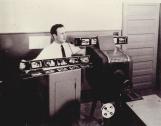 Credits:
Credits:North Huron Museum, Wingham, Ontario
16
Photographic Department ..."Events of interest in news, farm, sports, and the women's world are reviewed by department editors and their correspondents and with the assistance of the photographic department are relayed to television viewers." (this is Channel 8 booklet, c. 1955)
Design Department
Design Department
-Design department is conferred with as soon as a television program is hinted at - set is considered first. Producer presents his rough sketches and ideas. The designers discuss these with a view to practicability and available materials. A grid floor plan is made up and models of the sets produced. When these have been approved, the sets themselves - which sometimes can be massive - are constructed by the carpenters and painted by the scenic artists. The carpentry and the paint shops are well-equipped with hand and power tools, spray painting equipment, and even a heavy-duty sewing machine.(OST-21, 1955, p. 4)
-Lettering - lettering for title cards and signs to be used in the studio settings, themselves are done by the graphic artists. (OST-21, p.4)
-Stage furnishings - that which cannot be manufactured on site, are obtained from the outside by the properties man-an expert who uses his memory to beg, borrow or buy articles for settings. He must consider expenditures carefully weighting current needs against the possibility of future uses. His "props room" soon acquires a wide stock of general items which can be used over and over again, including a number of rarities in the way of furniture and bric-a-brac.(OST-21, p.4)
-Colour - even though televising is actually done in black and white. Background settings are done in full colour especially for the tonal effect, which registers on the screen even though the colour themselves are lost. Great care has to be taken to prevent using too wide a range of color, which will produce "ghosting" or the appearance of double images, on the screen. A ten-tone grey scale is used by the designers, a scale which runs from solid black to white. Every one of the ten shades has its color equivalent, and every camera has to be tested separately for its ability to pick up the proper equivalent. Primary colours, such as red, yellow and blue, do not show up well on television. Their high reflectance value causes them to "kick back" and show up lightly. Secondary colours - within orange, green and purple range - show up the best, because of their greater absorptive powers. Contrasts, often necessary, have to be watched carefully. Whereas a blonde girl must have her face darkened somewhat to provide contrast, the contrast must not be too great or "ghosting" will again appear. The color or grey scale range on any one set must not exceed five tones of the ten possible tones on the scale. (OST-21, p.4)
-Make Up - once very important when lighting techniques were not as advanced as they are now. It is often confined to providing a solid skin tone foundation like pancake make-up as used in Hollywood and other film centers. (OST-21, p.4)
17
CKNX dark room1950s
CKNX Television & Radio station, Wingham, Ontario
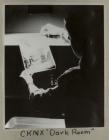 Credits:
Credits:North Huron Museum, Wingham, Ontario
18
Marilyn Lockridge and Hap Swatridge working in the CKNX film department1950-1970
CKNX Radio and Television, Wingham, Ontario
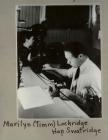 Credits:
Credits:North Huron Museum, Wingham, Ontario
19
Reg Bitton and Hap Swatridge film editors by day, musicians by night1955-1970
Channel 8, CKNX-TV, Wingham, Ontario
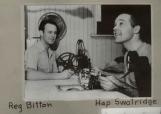 Credits:
Credits:North Huron Museum, Wingham, Ontario
20
Marilyn Timm in the film library of CKNX1955-1970
CKNX Radio and Television, Wingham, Ontario
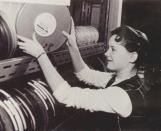 Credits:
Credits:North Huron Museum, Wingham, Ontario
21
The Control Room ...Master Control Room - all programs live and network go through their final stages in the control room as personnel perfect picture and sound before beaming the program to your TV screen."
The signal from the camera is transmitted to the control room - inside each camera is a plate- a sensitized surface - a mosaic of many tiny photo-electric cells - this plate takes the picture. The light from the image strikes the plate and identical images bounce off in form of electronic charges. Because the white portions of the image produce a great deal of electrical energy and the shaded portions less, the contrast in black and white is caused by the varying charges emanating from the photo-electric surfaces. (OST-9, 1955, p.20)
How a Television Camera Works
-the television camera uses no film but transmit images electronically (OST-26, 1955, p. 11)
-several cameras are needed in a studio because the electronic signal transmitted by a particular camera can be used at the very instant it is being sent out. Thus, when one scene is being covered from one position by one camera, the other cameras are being lined up, positioned and adjusted for the moment when their "shots" will be used. (OST-26, 1955, p. 11)
-each camera is equipped with an adjustable turret containing four lenses, so that the operator can get the type of shot he needs - a close-up, a medium shot, a long shot, wide-angle shot, etc. - by lining up the right lens with the "image orthicon" or picture taking tube. (OST-26, 1955, p. 11)
-a viewfinder on his camera which is, in reality, a monitor or small television receiving set, which reproduces the scene on which he has his camera focused. The electronic signals are returned from the control room to his camera for him to see and use as a guide or check in his work. (OST-26, 1955, p. 11)
-An invisible beam of electrons sweeps rapidly from left to right inside of the camera, scanning the image or picture, and producing electrical impulses as it strikes each photo-electric cell. These impulses create thousands of tiny dots, and each sweeps across each picture, breaking it up into as many as 350,000 dots or separate pieces. These pieces are sent out into space as a single-file parade of electrons which go out to reform the same electronic in home receiving sets. (OST-26, 1955, p. 11)
22
CKNX-TV control panel room1955-1970
CKNX-TV studios, Wingham, Ontario
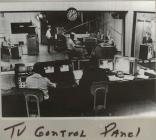 Credits:
Credits:North Huron Museum, Wingham, Ontario
23
Channel 8 went on air on November 18, 1955. (50 years, 1976, p.7-8) (VS-1, 1976)Those of us who were around during those early years of excitement and experimentation can attest to the thrill of accomplishment we all felt when we achieved our objectives, that first 'live' show. It occurred to me, however, as I watched this program, and it is a feeling shared by many of those who were a part of the Station in those earlier years, that a great deal more could and should be said about this unique enterprise that for so many years caused the people in this town to take pleasure in Wingham being known as "The Radio-TV Town of Canada." (Carbert essay, 1995)p.1
Live entertainment - over 20 hours of live television originates in the studios of CKNX television every week. The studio changes appearance with scenary moves and background changes for features like the news, sports, farm shows, women's programs and variety entertainment. (this is Channel 8 booklet, c. 1955)
I (Jim Swan) can remember the level of excitement surrounding that live broadcast. That is the one thing that is different about today's shows (Barn Dance) They aren't broadcast, so time isn't as critical. You have to be in a studio watching a clock to really appreciate what has to happen to bring a show like that right on the mark. Dead air couldn't happen, so musicians were expected to 'hit it' as soon as they were introduced. Any adjustments were done ahead of time or on the fly. Other than that, I think the shows are very close to what you would have heard and seen then. In fact, I suspect given the level of musicianship on today's show, the product today's audience gets is at least equal to, if not superior to what audiences heard back in the 50s. (BD-15, 2005)
Production of Television in 1955 - (OCT-11, p.30)
-how to create a half hour drama - "Western Ontario televiewers sitting at home and watching half hour drama would probably be shocked out of their comfortable easy chairs if they realized the cost and time involved in bringing into their living room this marvel." (OCT-11, p.30)
-starts with a script - the script editor selects, approves and checks for legal complications, copyright clearances and good taste - this all must be cleared two weeks prior to production
-casting - "a very ticklish assignment" - and a drawing up of a rehearsal schedule - all done at least two weeks prior to the production.
-production meeting - with producer and department of design follows immediately. Rough sketches and ideas for the setting are presented and a budget is set-up.
-scenic department have to create opening and closing titles and other lettering for the show
-special effects given to a script to produce anything from rain to an arctic blizzard.
-costumes and wardrobe are bought, rented, borrowed or designed as soon as cast determined, as well as make-up
-properties man hunts up accessories to furnish the set.
-musical director prepares the music - live or recorded
-production - producer sits down and tries to visualize the show, shot by shot, scene by scene - he plans action, figures out the camera angles and edits the play like a movie but without film - there is no opportunity to edit the production, it is seen as it is shoot.
-all leads to the final day - on that day - the producer sits in the control room with a script girl who watches the monitor for the cuing and the technical producer who operates the master switch.
-in front of the producer are the video control units, one for each camera and each showing the picture taken by each camera. The producer watches the monitor screens to decide when to make changes from camera one (long shot) to camera two (close up) etc. - as he decides he directs the technical producer to make the actual change - the technical producer is a "sorcerer who can fade the picture, print two and make one, superimpose one on the other - also in the control room is the sound or audio operator who regulates the sound portion of the show and takes care of special effects.
-outside the control room on stage are the actors who are emoting, cameramen keeping cameras trained on the scene with microphone boom men following the actors with a mike suspended on a boom outside camera range.
-outside camera range - an orchestra may be blaring forth with effect music to heighten the tension of the drama
-once a show is over and the actors rewarded with their paycheques, and the producer his laurels, the whole machinery is put into motion again as the old show is forgotten and the decks are cleared for the action for the next one. (OCT-11, p.30)
Truth of Acting in Television -
-"If you want to get into television, you must have the talent of professional or semi-professional caliber, backed by considerable training and experience, the stamina of a bush-pusher, the patience of Job, and a limitless fund of determination - that's the composite opinion of a number of topnotch CBC producers and announcers. (OCT-13, p.31)
"Best advice I can give the aspiring television artist. Get rid of the glamourous notions about radio life developed by the press agents below the border. Few television people make big money - most of them are plugging away at the job nearly around the clock." (OCT-13, p.31)
24
Channel 8 went on the air for the first time on November 18, 1955.18 November 1955
Channel 8, CKNX-TV, Wingham, Ontario
 Credits:
Credits:North Huron Museum, Wingham, Ontario
25
Ed Sullivan welcomed Channel 8 to television on his show.1955
Ed Sullivan show, New York, USA
 Credits:
Credits:North Huron Museum, Wingham, Ontario
26
1955 schedule of CKNX television programming1955
Channel 8, CKNX-TV, Wingham, Ontario
 Credits:
Credits:North Huron Museum, Wingham, Ontario
27
Off to a Good Start ..."The criss-crossed, red and white painted TV tower of station CKNX, Wingham (pop 2,800), soars 650 feet over the rich and rolling farmlands of Western Ontario that run inland from Lake Huron. Known to viewers as "Channel 8", the station beams in on an estimated 12,000 mainly rural homes, Wingham's is the only privately-owned rural television station in North America, the only small town TV station in Canada. A live and hustling enterprise, the station won last year's Showmanship Award given by Liberty magazine, edging out all of Canada's 35 other privately-owned stations. (O-1, 1958) p.15